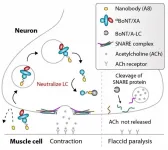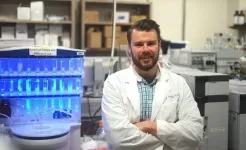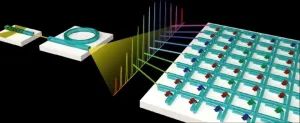Shiga toxin's not supposed to kill you
The terrible poison released by enterohemorrhagic E. coli seems intended to damp the immune system, not kill the host
2021-01-06
(Press-News.org) E. coli food poisoning is one of the worst food poisonings, causing bloody diarrhea and kidney damage. But all the carnage might be just an unintended side effect, researchers from UConn Health report in the 27 November issue of Science Immunology. Their findings might lead to more effective treatments for this potentially deadly disease.
Escherichia coli are a diverse group of bacteria that often live in animal guts. Many types of E. coli never make us sick; other varieties can cause traveler's diarrhea. But swallowing even a few cells of the type of E. coli that makes Shiga toxin can make us very, very ill. Shiga toxin damages blood vessels in the intestines, causing bloody diarrhea. If Shiga toxin gets into the bloodstream it can cause kidney failure.
"This is especially common in children; about 15% of kids with Shiga toxin-producing E. coli infections get kidney disease, and some can suffer long term kidney damage," says UConn Health immunologist Sivapriya Vanaja.
A group of Shiga toxin-producing E. coli called enterohemorrhagic E. coli, or EHEC, are especially common in the United States. When you hear that a batch of romaine lettuce is being recalled because of a dangerous outbreak of food poisoning, it's almost certainly due to EHEC.
EHEC normally live in cattle without making them sick. It used to be relatively common to have EHEC outbreaks coming from unhygienically prepared ground meat, but stringent regulations on slaughterhouses have made this less common. Now it's more likely for EHEC to appear on vegetables grown in fields adjacent to cattle or manure runoff.
But no matter where it comes from, once EHEC bacteria get inside a human, the infection is hard to treat. Antibiotics tend to make it worse--when the bacteria feel themselves dying, they make more Shiga toxin. And EHEC are very good at inhibiting the part of the immune system that normally responds early to this kind of infection, allowing them to grow unchecked in the human gut.
In a study led by Morena Havira, a postdoctoral fellow in Vanaja's lab, the team wanted to know how EHEC suppresses the immune system. The body normally responds to early stages of E. coli infections by activating an enzyme that kicks off an alarm inside cells. The cell bursts open to release a cloud of warning molecules that call other parts of the immune system to come and fight the bacteria.
But EHEC squashes that early response. To figure out how it does that, Vanaja and her colleagues decided to see which individual gene in EHEC was responsible. They took many different varieties of EHEC from a bacterial mutant library, and infected immune cells with them.
The team found that cells infected with EHEC that was missing the gene for Shiga toxin mustered a higher immune response compared to normal EHEC.
"It was surprising. Shiga toxin is very well-studied for its toxic activity; it wasn't known that it had another function," Dr. Vanaja says. So Shiga toxin's stealthy suppression of the immune system may have a link to all the bloody drama that ensues. Spurred on by this exciting observation, they conducted a series of detailed molecular studies, which revealed that Shiga toxin blocks a protein from bursting open the infected cell and alerting the body of infection.
Now that Vanaja and her colleagues know the specific molecular step Shiga toxin interferes with inside the immune cells, they are trying to figure out how, exactly, it blocks it. Once they know that, they may be able to find medicines that prevent toxin from interfering with immune responses.
INFORMATION:
ELSE PRESS RELEASES FROM THIS DATE:
2021-01-06
Taking advantage of the chemical properties of botulism toxins, two teams of researchers have fashioned non-toxic versions of these compounds that can deliver therapeutic antibodies to treat botulism, a potentially fatal disease with few approved treatments. The research, which was conducted in mice, guinea pigs, and nonhuman primates, suggests that the toxin derivatives could one day offer a platform to quickly treat established cases of botulism and target hard-to-reach molecules within neurons. Botulism manifests due to bacterial toxins called botulinum neurotoxins (BoNTs), which are the most potent toxins known ...
2021-01-06
The pandemic has exacerbated isolation and fears for one very vulnerable group of Americans: the 4.3 million older adults with cognitive impairment who live alone.
As the coronavirus continues to claim more lives and upend others, researchers led by UC San Francisco are calling for tailored services and support for older adults living alone with memory issues, who are experiencing extreme isolation, and are exposed to misinformation about the virus and barriers to accessing medical care.
In their qualitative study, researchers interviewed 24 San Francisco Bay Area residents whose average age was 82. Of these, 17 were women, and 13 were either monolingual Spanish-speakers ...
2021-01-06
LA JOLLA--New data suggest that nearly all COVID-19 survivors have the immune cells necessary to fight re-infection.
The findings, based on analyses of blood samples from 188 COVID-19 patients, suggest that responses to the novel coronavirus, SARS-CoV-2, from all major players in the "adaptive" immune system, which learns to fight specific pathogens, can last for at least eight months after the onset of symptoms from the initial infection.
"Our data suggest that the immune response is there--and it stays," LJI Professor Alessandro Sette, Dr. Biol. Sci., who co-led the study with LJI Professor Shane Crotty, ...
2021-01-06
Drug-resistant bacteria could lead to more deaths than cancer by 2050, according to a report commissioned by the United Kingdom in 2014 and jointly supported by the U.K. government and the Wellcome Trust. In an effort to reduce the potential infection-caused 10 million deaths worldwide, Penn State researcher Scott Medina has developed a peptide, or small protein, that can target a specific pathogen without damaging the good bacteria that bolsters the immune system.
Medina, an assistant professor of biomedical engineering, led the team who published its results Jan. 4 in Nature Biomedical Engineering.
"One of the best protective mechanisms we have to prevent infection are beneficial bacteria that inhabit our bodies, known as commensals," ...
2021-01-06
Ikoma, Japan - Ultrasmall integrated circuits have revolutionized mobile phones, home appliances, cars, and other everyday technologies. To further miniaturize electronics and enable advanced functions, circuits must be reliably fabricated in three dimensions. Achieving ultrafine 3D shape control by etching into silicon is difficult because even atomic-scale damage reduces device performance. Researchers at Nara Institute of Science and Technology (NAIST) report, in a new study seen in Crystal Growth and Design, silicon etched to adopt the shape of atomically smooth pyramids. Coating these silicon pyramids with a thin layer of iron imparts ...
2021-01-06
ITHACA, N.Y. - For more than seven years, a mysterious wasting disease has nearly killed off sea star populations around the world. Some of these species stand at the brink of extinction.
New Cornell University-led research suggests that starfish, victims of sea star wasting disease (SSWD), may actually be in respiratory distress - literally "drowning" in their own environment - as elevated microbial activity derived from nearby organic matter and warm ocean temperatures rob the creatures of their ability to breathe.
"As humans, we breathe, we ventilate, we bring air into our lungs ...
2021-01-06
In the digital age, data traffic is growing at an exponential rate. The demands on computing power for applications in artificial intelligence such as pattern and speech recognition in particular, or for self-driving vehicles, often exceeds the capacities of conventional computer processors. Working together with an international team, researchers at the University of Münster are developing new approaches and process architectures which can cope with these tasks extremely efficient. They have now shown that so-called photonic processors, with which data is processed by means of light, can process information much more rapidly and in parallel - something ...
2021-01-06
Young adults ages 18-24 years old in the U.S. say that porn is their most helpful source of information about how to have sex, according to a new study led by a Boston University School of Public Health (BUSPH) researcher published in the journal Archives of Sexual Behavior.
In the nationally representative survey, a quarter of young adults said porn was their most helpful source of information about how to have sex. Slightly less than a quarter said sexual partners were the most helpful source, and fewer pointed to friends, parents, media, or healthcare professionals. However, female respondents were much more likely than male respondents to report that their partners ...
2021-01-06
2020 was an eventful year, with science at the front and center of most news cycles. As this seemingly long year wraps up, Chemical & Engineering News (C&EN), the weekly newsmagazine of the American Chemical Society, is highlighting the biggest chemistry stories, top research trends and predictions for the coming year.
Predictably, research on the novel coronavirus was the biggest chemistry story of the year, beginning in January when the genetic code for SARS-CoV-2 was published. Since then, thousands of papers have been published on the subject, with topics like mask efficacy, disinfectants and virus transmission getting the most attention. Other popular chemistry subjects included new insights about the atmospheres of other planets and how climate change fueled ...
2021-01-06
Cardiovascular disease is the leading cause of death associated with smoking cigarettes. But as use of e-cigarettes ("vaping") becomes more popular, including as a way to cut back on cigarettes, little is known about its effect on cardiovascular health.
Now, a new Boston University School of Public Health (BUSPH) study, published in the journal Circulation, finds that vaping may not cut risk of cardiovascular disease in the way that most adults use them--in combination with cigarettes.
"Dual use of cigarettes and e-cigarettes appears to be as harmful to cardiovascular health as exclusive cigarette smoking," says study lead author Dr. Andrew Stokes, assistant professor of global health at BUSPH.
Stokes ...
LAST 30 PRESS RELEASES:
[Press-News.org] Shiga toxin's not supposed to kill you
The terrible poison released by enterohemorrhagic E. coli seems intended to damp the immune system, not kill the host


